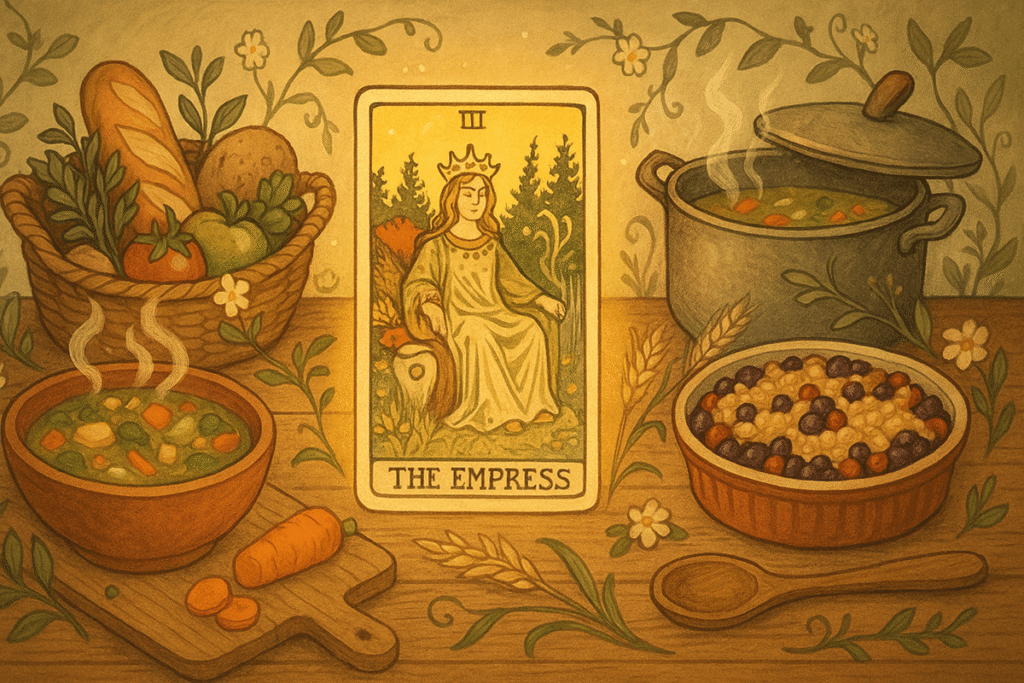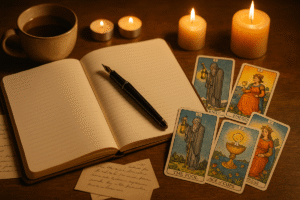Table of Contents
There’s something about The Empress card that always makes me want to be in the kitchen. Maybe it’s the lush garden imagery, or perhaps the sense of abundance that radiates from her presence. She sits there, surrounded by wheat and flowing water, embodying everything nurturing and generative. When this card appears in a reading, I find myself thinking about growth, creativity, and the simple pleasure of making something with my own hands.
Cooking, I’ve come to realize, offers a similar space for reflection. The rhythm of chopping vegetables, the aroma of herbs releasing their essence, the transformation of raw ingredients into something nourishing… these acts mirror the creative energy The Empress represents. Today, I want to share a recipe that captures this feeling. It’s a harvest vegetable and wild rice soup that feels like edible comfort, something that embodies the card’s themes of abundance and care.
But before we get to the actual cooking, let’s spend a moment with The Empress herself.
The Empress as Creative Nourishment
When The Empress shows up, she often invites us to consider how we’re nurturing ourselves and others. She’s not demanding or urgent. Instead, she offers a gentle reminder about the importance of creation, growth, and receptivity. In the traditional Rider Waite Smith deck, she’s surrounded by symbols of fertility and harvest. Yet I think her message extends beyond literal abundance into something more personal.
What does it mean to nurture yourself right now? That question surfaces for me whenever I encounter this card. Sometimes nurturing looks like rest. Other times, it’s about actively creating something, using your hands and energy to bring something new into existence. Cooking occupies this interesting middle ground between activity and meditation. You’re doing something productive, yet the process itself can be deeply calming if you let it.
The Empress also speaks to sensory experience. She’s rooted in the physical world, in textures and tastes and the feeling of earth under your feet. This recipe attempts to honor that sensory richness through layers of flavor and color.
Mindfulness in the Kitchen
I wasn’t always someone who cooked mindfully. For years, meal preparation felt like just another task, something to rush through on the way to whatever came next. Perhaps you’ve experienced this too. The shift happened gradually when I started treating cooking less like a chore and more like a small ritual.
The key, I think, is removing the pressure to be perfect or efficient. When you’re cooking with The Empress energy, there’s no race. You can take your time washing each vegetable, noticing the weight of a carrot in your hand or the way parsley smells when you run your fingers through it. These small observations might seem insignificant, but they anchor you in the present moment.
This soup recipe is particularly suited to mindful preparation because it involves multiple stages. Each step offers an opportunity to slow down and notice what’s happening. The vegetables need chopping. The rice needs rinsing. Aromatics need sautéing. None of it is complicated, but all of it benefits from attention.
Gathering Your Ingredients
Before we begin, let’s talk about what you’ll need. The beauty of this recipe is its flexibility. The Empress doesn’t demand rigid adherence to rules; she encourages working with what’s abundant and available to you.
For the base, you’ll want good olive oil, one large onion, three or four cloves of garlic, and a few stalks of celery. I usually use three, but two would work fine. You’ll also need one cup of wild rice. I prefer wild rice for this soup because it has a nutty, earthy quality that feels grounding, though you could substitute brown rice or even farro if that’s what you have.
The vegetables are where you can really embrace abundance. I typically use two medium carrots, one sweet potato, one small butternut squash, a handful of green beans, and whatever leafy greens look good at the market. Kale works beautifully here. Chard would be lovely too. You’ll need about two cups of greens, roughly chopped.
For the broth, use six cups of vegetable stock. Homemade is wonderful if you have it, but store bought works perfectly well. Add to your list one can of diced tomatoes, a bay leaf, some fresh thyme, salt, and pepper. If you have parmesan rind sitting in your refrigerator, throw that in too. It adds remarkable depth.
The Process of Creation
Start by rinsing your wild rice thoroughly. This step matters more than you might think. Wild rice can have a slightly dusty quality if you skip the rinse. I usually put it in a fine mesh strainer and run cold water over it until the water runs clear. Set it aside.
Now comes the meditation of chopping. Dice your onion. I aim for pieces roughly a quarter inch, though precision isn’t the point here. Mince the garlic. Slice the celery. Peel and cube the carrots, sweet potato, and butternut squash into bite sized pieces. Trim the green beans and cut them into one inch segments. This prep work probably takes fifteen or twenty minutes, and I encourage you to sink into it. Notice the different textures, the way each vegetable responds differently to your knife.
Heat a large pot or Dutch oven over medium heat. Add two tablespoons of olive oil. When it shimmers, add the onion and celery. Let them cook for about five minutes, stirring occasionally, until the onion becomes translucent. The kitchen will start to smell incredible at this point. Add the garlic and cook for another minute, just until fragrant. Garlic burns easily, so watch it.
Here’s where the soup begins to build its layers. Add the wild rice to the pot, stirring to coat it with the oil and aromatics. Toast it for a minute or two. This step isn’t absolutely necessary, but I find it deepens the nutty flavor. Pour in your vegetable stock, then add the tomatoes with their juice, the bay leaf, and a few sprigs of fresh thyme. If you’re using a parmesan rind, nestle it into the liquid now.
Bring everything to a boil, then reduce the heat to maintain a gentle simmer. Cover the pot and let it cook for about thirty minutes. Wild rice takes longer than white rice, so patience is required here. This waiting period is part of the process, though. You might tidy the kitchen, or simply sit nearby with a cup of tea.
After thirty minutes, add the carrots, sweet potato, and butternut squash. These sturdier vegetables need a good twenty to twenty five minutes to become tender. Continue simmering, still covered. The soup will start to smell rich and earthy, like autumn concentrated into liquid form.
When the rice is tender and the root vegetables yield easily to a fork, add the green beans. They’ll need just five minutes or so. You want them to retain some texture. Finally, stir in your chopped greens. They’ll wilt almost immediately in the hot liquid. Remove the pot from heat.
Taste the soup now. It probably needs salt. I usually add about a teaspoon, but your preference might differ. Add some freshly ground black pepper too. Fish out the bay leaf, the thyme stems, and the parmesan rind if you used one. The rind will have given the soup a subtle savory depth, but it’s not meant to be eaten.
Serving and Savoring
This soup wants to be served simply. Ladle it into wide bowls. I like to drizzle a little extra olive oil on top and maybe add a sprinkle of grated parmesan. Some crusty bread on the side makes sense too, something to soak up the broth.
But the real invitation here is to eat mindfully. Feel the warmth of the bowl in your hands. Notice the colors, the way the orange of the sweet potato contrasts with the dark green of the kale. Take your first spoonful slowly. The soup should taste layered, with the sweetness of the root vegetables balanced by the earthiness of the wild rice and the slight acidity from the tomatoes.
This is Empress energy in edible form. It’s abundant without being overwhelming. It nourishes without being heavy. And perhaps most importantly, it was created with attention and care.
Reflection Questions for Your Practice
After you’ve made and enjoyed this soup, you might want to spend a few minutes with these questions. The Empress often prompts us to examine our relationship with creativity and nourishment.
What did you notice during the preparation process? Were there moments when your mind wandered, or times when you felt fully present? There’s no right answer here; the point is simply to observe your own experience.
How do you typically nurture yourself? Is it through food, through rest, through creative projects, or through something else entirely? The Empress reminds us that self care isn’t one size fits all. What feels nourishing to you might look completely different from what works for someone else.
When you think about abundance in your life, what comes to mind? Abundance doesn’t always mean material wealth. Sometimes it’s about having enough time, or meaningful relationships, or creative energy. What feels abundant for you right now?
These questions don’t require immediate answers. You might return to them over several days, letting your thoughts develop gradually. That’s very much in keeping with The Empress’s patient, receptive energy.
Making This Recipe Your Own
The recipe I’ve shared is really more of a template than a strict formula. The Empress encourages generative creativity, and that includes adapting things to suit your needs and preferences. If you don’t like wild rice, use another grain. If butternut squash isn’t in season, substitute zucchini or mushrooms. Vegetarian versions can easily become vegan by omitting the parmesan. You could add white beans for extra protein, or stir in some fresh lemon juice at the end for brightness.
The heart of this recipe isn’t about following directions perfectly. It’s about the intention you bring to the process and the way you engage with the act of creating something nourishing. That’s the real lesson The Empress offers. Whether in tarot, in cooking, or in life more broadly, she invites us to approach creation with patience, attention, and generosity.
So perhaps the next time you encounter The Empress in a reading, consider spending some time in the kitchen. Let the process of cooking become a form of meditation. Notice what emerges when you give yourself permission to slow down and create something with care. You might be surprised by what you discover about yourself in the process.
Frequently Asked Questions
Can I substitute ingredients in this recipe if I don’t have everything on hand?
Absolutely. The spirit of this recipe is flexibility and working with what’s abundant to you. Use brown rice or farro instead of wild rice, swap butternut squash for zucchini or mushrooms, and choose whatever greens look good at your market. The goal is to create something nourishing with intention, not to follow a rigid formula.
How long does this soup keep in the refrigerator?
This soup stores beautifully for up to five days in an airtight container in the fridge. The flavors actually deepen over time as the vegetables continue to absorb the broth. You can also freeze portions for up to three months, making it perfect for meal prep or future mindful eating moments.
Do I need to know about tarot to make this recipe meaningful?
Not at all. While the recipe draws inspiration from The Empress card’s themes of nurturing and abundance, you can simply approach it as an invitation to cook more mindfully. The reflective questions and focus on sensory awareness work for anyone wanting to slow down and be more present in the kitchen, regardless of familiarity with tarot.
What if I struggle to stay focused while cooking?
It’s completely normal for your mind to wander during meal preparation. When you notice your attention drifting, gently bring it back to what you’re doing without judgment. Start with just being present for one step, like chopping the vegetables or stirring the pot, rather than trying to maintain perfect focus for the entire cooking process.







